Correct planting of raspberry seedlings in the fall: when and how to plant in open ground
Raspberry is one of the most popular berry bushes, yielding in early to mid-summer (i.e. after honeysuckle and strawberries). Few people do not like to feast on this delicious and healthy berry, so almost every summer resident has at least several bushes on the site.
But, most likely, you do not have one yet, which is why you decided to find material on when and how to plant raspberries in the fall. Actually, you are on the right track. In this material you will find answers to all your questions regarding the autumn planting of raspberry seedlings in open ground, as well as further care for berry bushes.
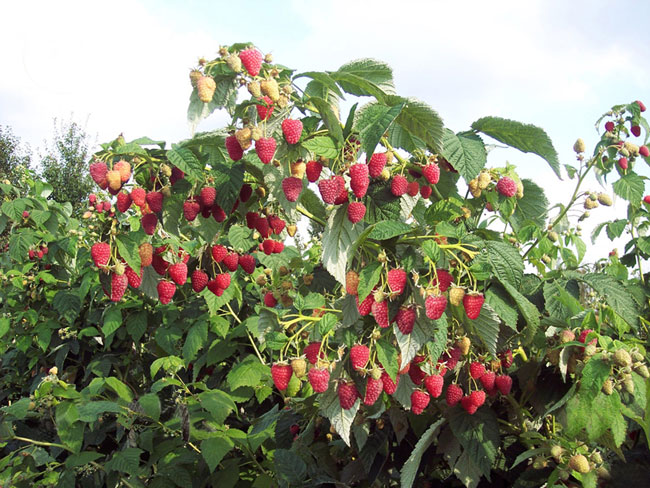
Content
- 1 When is it better to plant raspberries in the fall, in what month: optimal timing
- 2 Raspberry planting methods: preparation of planting holes and trenches
- 3 How to properly plant raspberries in the fall in a planting hole or trench
- 4 Further care of raspberries after autumn planting
- 5 Possible mistakes when planting raspberries in the fall
When is it better to plant raspberries in the fall, in what month: optimal timing
Many gardeners believe that the best time to plant raspberries is autumn, because in the spring the shrub starts growing very early and you may simply not have time, but you need to plant "before".
By this time, the seedlings stop vegetating, they end up growing and ripening shoots.
As for the specific dates, namely in which month it is better to plant raspberries in the fall, then depending on the climatic conditions of the region (i.e. your place of residence), autumn planting of raspberries is carried out early (in the first half of September) or late autumn (in October).
The fact is that the seedlings must have time to take root well before the onset of cold weather and successfully prepare for winter. In other words, there should be a supply of about a month before the first frost.
Important! If you are late with the autumn planting of raspberry seedlings, then they may simply not have time to take root before the soil freezes and freeze in winter.
And in the spring, seedlings planted in the fall will quickly grow, grow shoots and even begin to bear fruit (of course, if it is a remontant variety that can yield crops on the shoots of the current year).
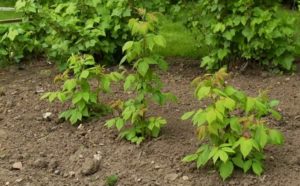
As for when it is better to plant raspberries - in autumn or spring, it is very difficult to give a definite answer. Therefore, each gardener decides on his own when it is more convenient for him to plant raspberries, so to speak, as needed and the availability of free time.
Important! More details about planting raspberries in spring read in this article.
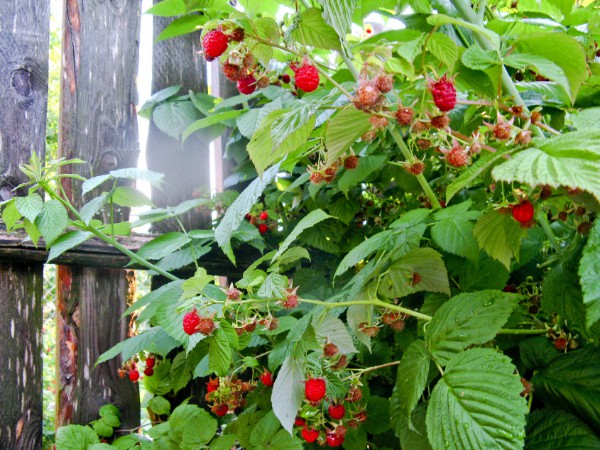
Planting dates in autumn in different regions
As mentioned earlier, depending on the climatic characteristics of your region of residence, the timing of the autumn planting of raspberries will vary:
- So, in the South of Russia, raspberries can be planted until late autumn - the second half of October.
- Gardeners of the Middle Strip and the Moscow Region should have time to plant raspberries before the end of September.
- In colder regions - in the North-West (in the Leningrad region), as well as in Siberia and the Urals, raspberries are planted in early autumn - in the first half of September.
In any case, the main condition is that there should be another 20-30 days before the first frost. Therefore, first of all, be guided by the current weather conditions and the medium-term weather forecast.
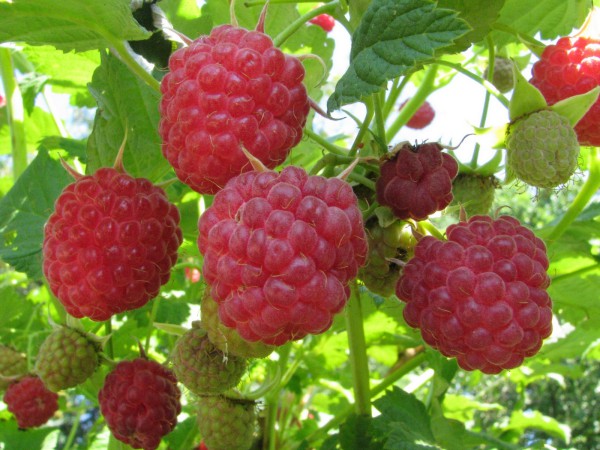
According to the lunar calendar in 2020
Choose the optimal date for planting seedlings can help you moon calendar.
So, favorable days for planting raspberries in the fall in 2020, according to the lunar calendar, are:
- in September - 19-26;
- in October - 3-13, 18-21.
Unfortunately, it is not always possible to get to the dacha on the indicated days, so the main thing is not to land on dates that are not suitable for the lunar calendar (the days of the Full Moon and New Moon, as well as the period when the Moon is in Aquarius, since this is a barren and dry sign -italicized).
Unfavorable days, according to the lunar calendar, for 2020 for the autumn planting of raspberry seedlings, the following dates are:
- in August -3, 4-5, 19, 31;
- in September -1, 2, 17, 27-28.
- in October - 2, 16,24-26, 31
- in November - 15,20-22, 30.
According to the lunar calendar, from the magazine "1000 Tips for Summer Residents".
Raspberry planting methods: preparation of planting holes and trenches
Typically, choosing one of two methods for planting raspberries depends on the type of soil in your area.
If sandy soil, in other words, the water leaves very quickly, the raspberries will constantly need moisture. Therefore, in this case, they dig trench and fill it with fertile soil that retains moisture well.
Interesting! However, often raspberries are planted in trenches simply because it is much more convenient and faster to make a raspberry plantation, and not because of the type of soil.
On the contrary, if the soil you heavy and clayey, then it is better to plant raspberries on high beds (15-20 cm).
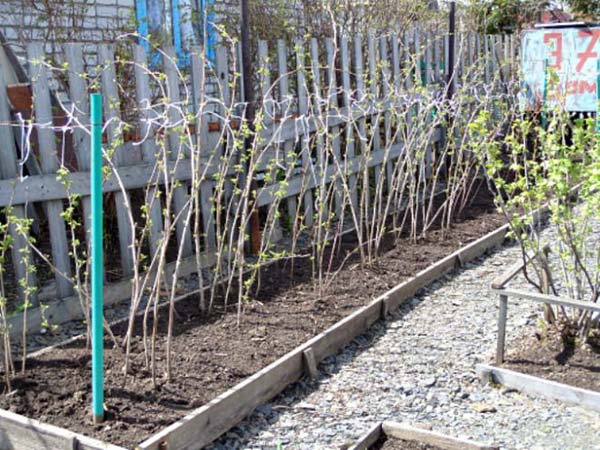
However, most often raspberries are planted in ordinary planting pits (bush method).
Regardless of the landing method the area for the autumn planting of raspberries should be prepared in advance, at least 2 weeks before planting seedlings, and even better a month (optimally - in spring).
First of all, you should to clear the selected area from weeds, as they severely deplete and dry out the soil. In addition, many pests and diseases hide and hibernate in them.
Note! In no case should you plant raspberries on an area clogged with weeds, especially wheatgrass. The fact is that the wheatgrass rhizomes lie deep enough and, moreover, branch very strongly, so getting rid of them after planting the seedlings will be very problematic.
Landing in a hole (bush method)
- With the bush method of planting raspberries, you need to dig a planting hole with a depth and width (diameter) of 30-40 cm.
- Next, pour a bucket of humus mixed with phosphoric and potash fertilizers.
Your choice (one of two):
Mineral fertilizers: superphosphate (50-80 grams) and potassium sulfate (30-50 grams).
Organic fertilizers: bone meal (100-200 grams), wood ash (100-200 grams).
- Then top up with fertile soil mixed with humus (2 to 1).
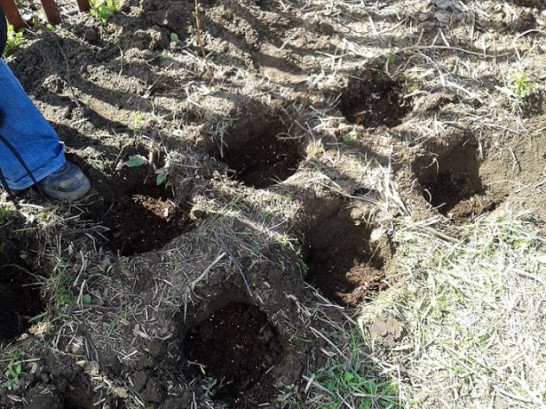
- Plant a seedling.
Trench method
First of all, the trench itself should be correctly placed on the site, namely, it should be dug from south to north (or from north to south) so that the eastern part is illuminated in the morning, and the western part from the second half. Thus, the plant will develop evenly and receive adequate lighting for normal vegetation and photosynthesis processes.
When digging a trench, it is very convenient to fold the upper fertile layer on one side of the trench (in the future it will be required), and the deep one on the other (we will no longer need it).
The optimal size of the trench for planting raspberries is 40 cm wide and 40 cm deep (sometimes up to 50 cm), and in length - as necessary and possible.
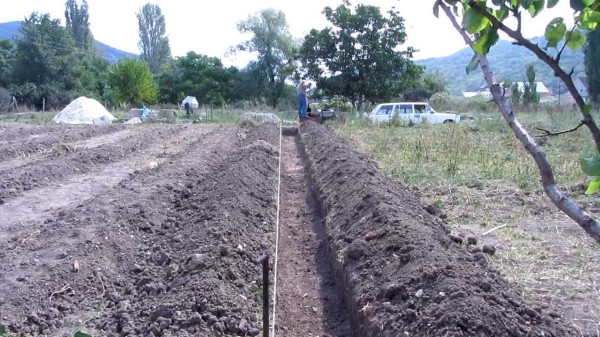
Next, you need to properly fill the trench:
If you see that the ground is dry, then first you should carry out moisture-charging irrigation.
- 1st layer (15-20 cm). Pour humus on the bottom of the pit (2-3 buckets per running meter).
Important! Sometimes it is advised to lay slightly rotten twigs and pieces of wood at the bottom of the pit, and also pour the mowed grass on top. However, it must be understood that when they rot, your seedling can take and go underground, while the root collar will be deepened, which should not be allowed.
- 2nd layer (20-25 cm). Sprinkle on top phosphoric and potash fertilizers. If desired, they can be dug up with 1 layer of humus.
Of your choice;
Mineral fertilizers: superphosphate (90-120 grams per running meter) and potassium sulfate (60-90 grams per running meter).
Organic fertilizers: bone meal (200-400 gr), wood ash (200-400 gr).
- 3rd layer. This will be the top fertile soil layer with humus (2 to 1).
- Plant seedlings.
Video: planting raspberries in a trench way (1st and 2nd part).
Opinion! “I would still advise planting raspberries in trenches, and not in pits, as this culture has a branched root system and replacement shoots will appear throughout the entire ridge and therefore it should be well filled. And since raspberry shoots require a garter to the trellis, it is preferable to arrange it in rows. "
How to limit the reproduction and spread of shrubs on the site during planting, so that later you do not suffer
If you want to limit the growth of raspberries (and it is highly recommended to do this if you do not want the raspberries to begin to take over the nearby area), then in the aisles you should bury sheets of slate, old roofing iron or similar material to a depth of 40-50 centimeters.
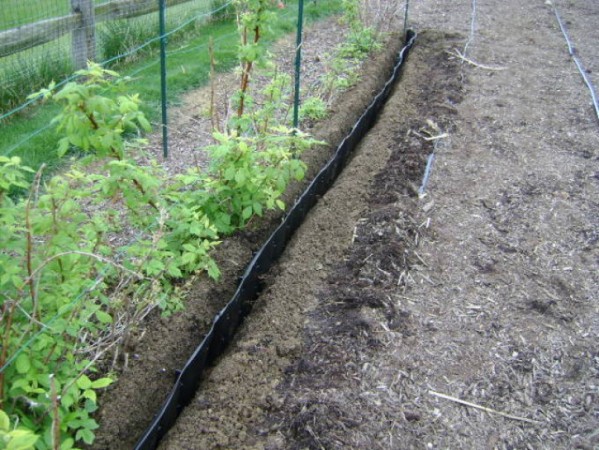
Idea! Alternatively, you can do warm bed with slate fencing.
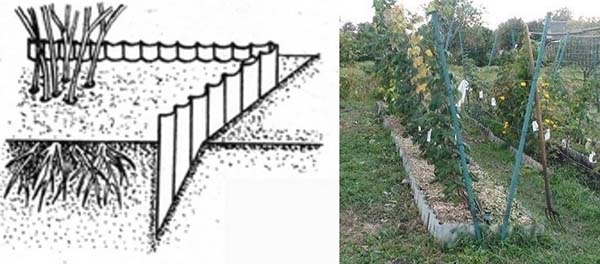
How to properly plant raspberries in autumn landing pit or trench
Before starting to engage in direct planting, of course, you first need to purchase high-quality seedlings, decide on a suitable place on the site and choose a planting method.We will talk about how to do this correctly further.
What should be a seedling
In the fall, it is not at all difficult to get high-quality planting material. This is due to the fact that raspberries form many root suckers, which are used as seedlings.
A high-quality root offspring should have a well-developed fibrous root system 15-20 cm long.Its aboveground part should consist of several stems (annual shoots), with a base thickness of at least 1 cm.The appearance itself should be healthy, without visible damage from diseases and pests ...
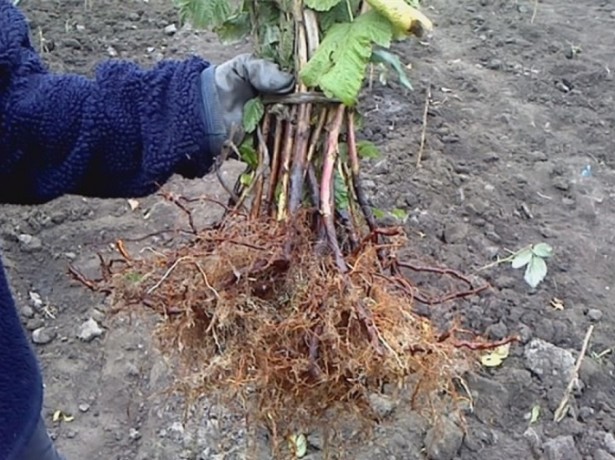
If the seedling is tall, then before planting it is cut to a level of 20-25 cm from the base. This is necessary so that it pulls less nutrients on itself, giving the root systemstrength for rooting.
Note! If you want to plant or transplant a raspberry bush to a new location (and not buy and plant from scratch), then help you this material on raspberry transplant.
Landing place
Raspberries are one of the most sunlight-demanding shrubs, for which you will need to identify the most illuminated place in the garden... The thing is that with a lack of light, raspberry shoots stretch out, their lower part becomes bare, the number and size of berries decreases, and moreover, they lose their sweetness.
Of course, raspberries can also grow in light partial shade (shading should be short), but if you plant a berry bush in a shady place, then you may not even dream of large and sweet berries, no matter how hard you try and feed your raspberry.
In addition, the site must be protected from drafts and strong winds.
For example, it will be just fine if on the north side the raspberry plantations are protected by a fence or some other obstacle.
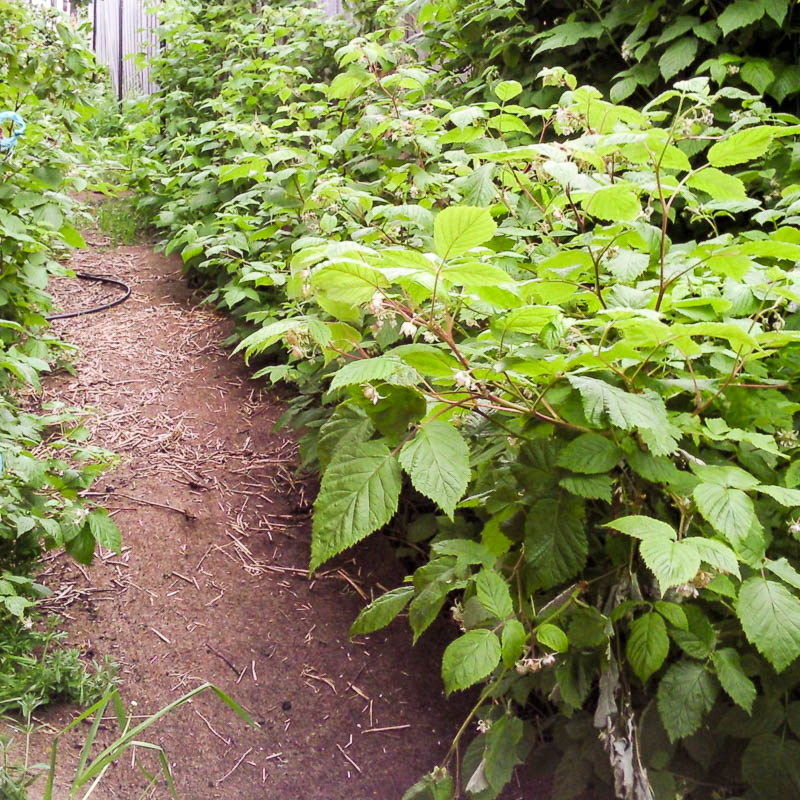
What soil is needed
The soil for planting raspberries should be sufficient loose and fertile.
Advice! Depending on the fertility structure of your land, when you start preparing the planting pits or trenches, you will need to make sure to apply mineral and organic fertilizers.
This is due to the fact that the bush superficial root system, which can successfully develop only in cultivated (arable) land. Accordingly, raspberries are very demanding on soil moisture, therefore the soil should it is good to pass oxygen and moisture to the roots. At the same time, the water should not stagnate in any case, because the shrub does not tolerate strong waterlogging and high groundwater.
Prolonged stagnation of water and waterlogging of the raspberry tree lead to the death of roots and the subsequent death of plants.
Thus, the ideal soil for planting raspberries is loamy and sandy loam soil.
Optimal soil acidity for successful cultivation of raspberries - 5.5-6.5 pH (slightly acidic-neutral).
On alkaline or acidified soils, raspberries will just sit, and not develop and bear fruit.
Distance between bushes and rows
Raspberries are planted in such a way that a distance of 50-80 cm remains between the bushes (depending on which variety is vigorous or not), and in the aisles - 1.2-2 meters.
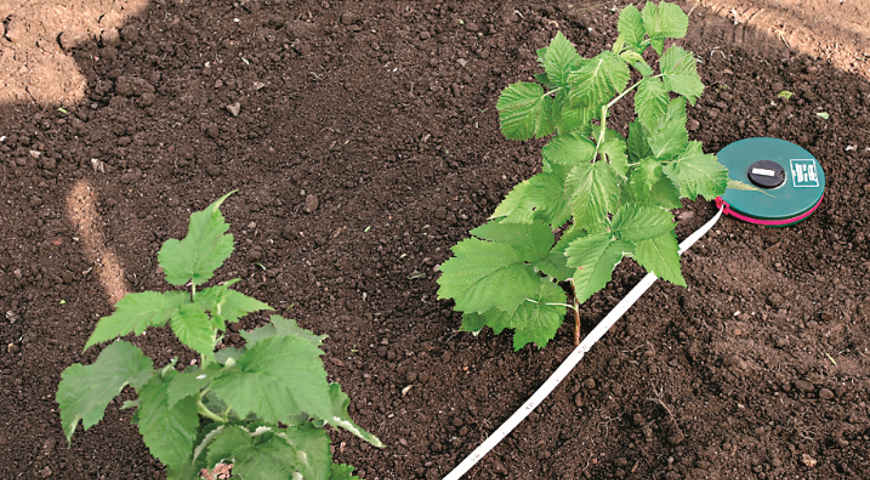
This distance allows you to conveniently harvest and take care of the berry bushes. In addition, plants planted at such a distance do not interfere with each other, they have enough food and sunlight (since the bushes do not shade each other).
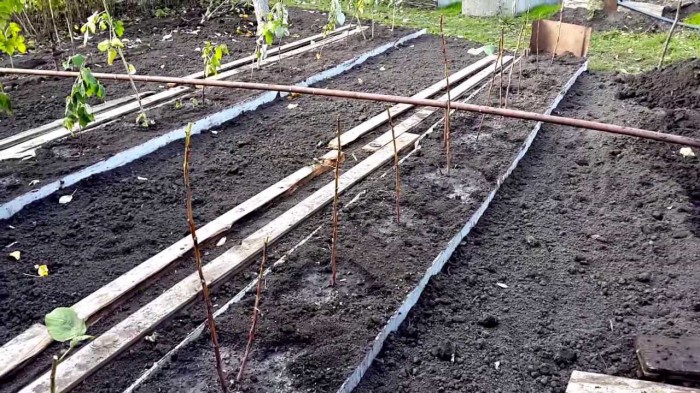
Landing hole and planting depth
As a rule, a hole 40-50 cm deep is dug for planting raspberries.At the same time, its width and length, as a rule, are also the same 40-50 cm. These dimensions of the planting hole allow you to make all the necessary organic and mineral fertilizers required for active growth and abundant fruiting of the berry bush.
The very same planting of the seedling is carried out so that the root collar (replacement buds) is eventually at the soil level.
Direct landing
Step-by-step instructions for planting raspberries in the fall:
- Place the seedling in the center of the planting hole or trench on a small mound, and then gently and evenly spread its roots.
Make sure that the roots do not bend upwards under any circumstances.
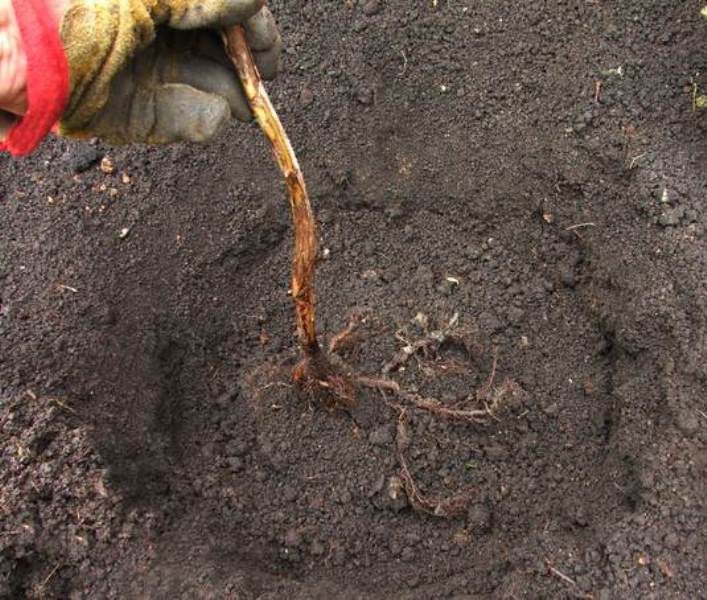
Interesting! Some experts recommend planting raspberry seedlings with an open root system directly in the slurry, and for this, first spill a hole or trench abundantly with water. You can also try this:
- Sprinkle with fertile garden soil mixed with humus (2 to 1).
Falling asleep with soil, it is recommended to slightly raise the seedling several times so that the roots come into better contact with the soil and no voids form around them.
As a result, the root collar (replacement buds) should be at the soil level.
- Compact the soil around the seedling.
- Spill abundantly with water (5-10 liters) to ensure maximum contact between roots and soil.
- The planting of the seedling is completed, but a couple of nuances remain, which will be described later.
Video: planting raspberries correctly in the fall
Are there any differences in planting and caring for remontant raspberries
There are no differences in planting, but there are a couple in care and cultivation techniques.
The whole difference between remontant and regular raspberries is that remontant raspberries can bear fruit both on the shoots of the current year and the past, i.e. instead of one harvest, you can get two (1st time - in June-July, 2nd time - in August-September).
However, it is worth knowing that the second (autumn) harvest of remontant raspberries is less tasty, while the first (summer) harvest is not inferior to the taste of the usual (although many may disagree).
Nevertheless, it makes sense to have both regular and remontant varieties on the site in order to collect tasty and healthy berries in summer and autumn.
Naturally, remontant raspberries are more demanding on light, watering and feeding than ordinary ones, which is quite logically explained by its greater fertility.
Video: features of planting and caring for remontant raspberries
Further care of raspberries after autumn planting
The autumn planting of raspberries is almost complete, it remains only to trim the planted seedlings, if they have not yet been trimmed by the seller (as a rule, they sell or send just such), mulch them, and then prepare them for winter. Saplings are cut, leaving a stem height of 15-25 cm (maximum up to 30 cm) or 3-4 healthy buds.
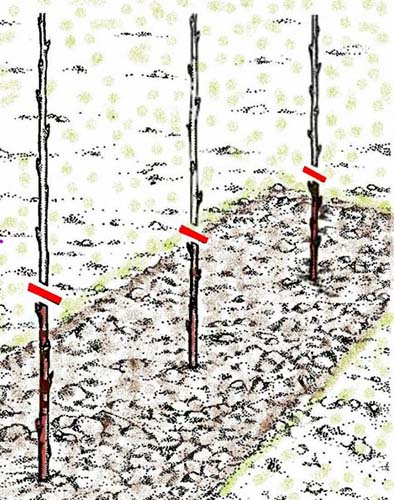
Worth knowing! Why is this (pruning after planting) so necessary?
The fact is that in this way you equalize the underground and aboveground parts of the plant, thereby activating the growth of replacement buds and better development of the root system, because at the moment the seedling must first of all take root in order to successfully overwinter.
Further it is highly desirable mulch near-trunk circle of raspberry seedlings. Peat, grass cuttings, hay, straw or rotted sawdust are perfect for this.
Caution! Fallen foliage is not the best option for mulching, as it can contain various pests and pathogens (fungi).
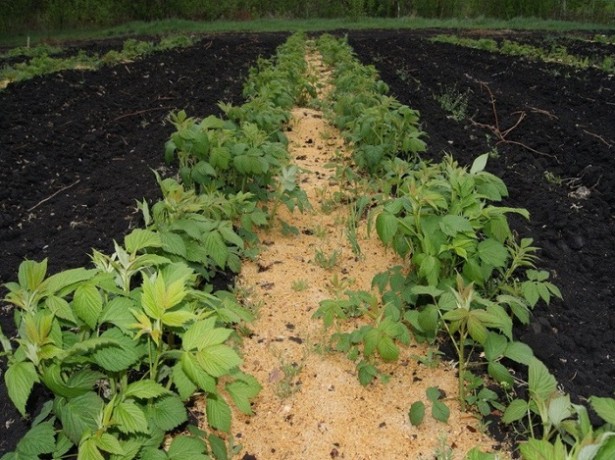
Why you need to mulch raspberries and other plants:
- After abundant watering, a dry crust often forms. Thanks to mulch, the soil will always be loose and moisture will last longer.
- Weeds, which raspberries do not like so much, will not grow under the mulch.
- Mulch is an excellent organic food supplement.
You should also monitor the moisture content of the soil, since a lot of moisture is required for successful rooting, in other words, in the event of a dry autumn, do not forget about watering.
In general, any raspberry is very fond of watering (especially remontant), and abundant.
And in the fall you will need prepare the bushes for winter (however, a layer of mulch of 10-15 cm will be enough).
Advice! About, how to care for raspberries in autumn and properly prepare them for winter, painted in detail in this article.
In the future, among basic agrotechnical measures for the care of raspberries will include the following:
- annual pruning after fruiting (in autumn) or in early spring;
Basic trimming raspberries perform, as a rule, after fruiting (in autumn), and in the spring they do only corrective, or rather sanitary pruning.
Of course, if you have not had the opportunity to prune raspberries in the fall, then pruning in the spring is better than not pruning at all.
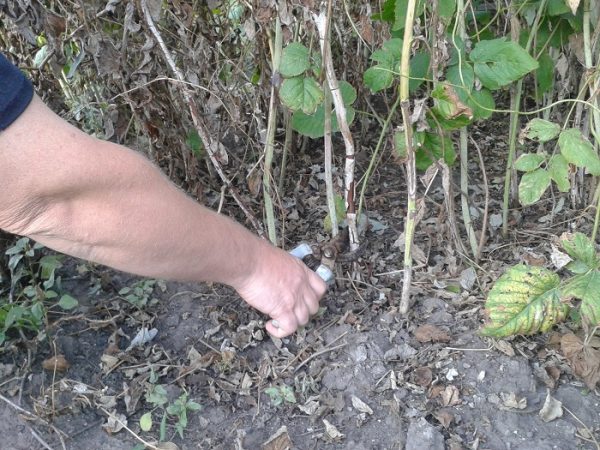
- garter shoots;
By the way! About, how to tie up raspberries in spring and autumn, you can read in this material.
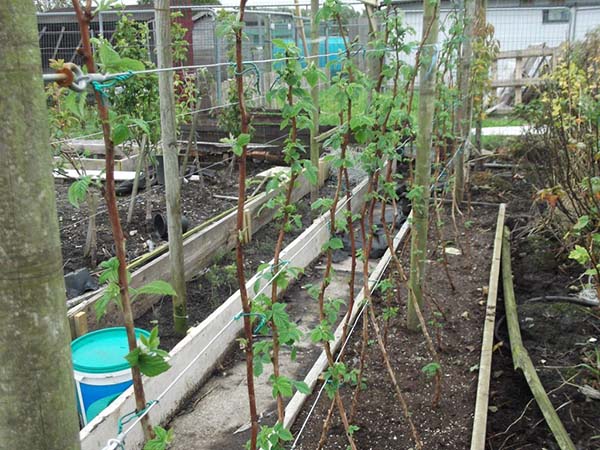
- fertilization;
Advice! The site already has detailed materials about spring feeding raspberriesand also about autumn.
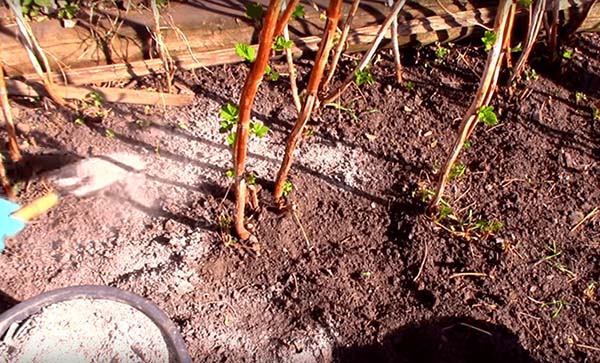
- treatment for diseases and pests.
Important! About, what and how to spray raspberries in the spring, written in detail in this article.
- If the raspberries are too big then it should be mandatory plant and transplant.
By the way! How to do it right in spring, summer or autumn, read here.
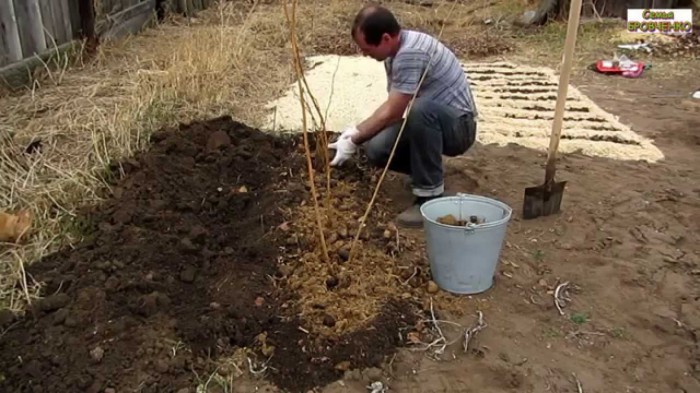
Possible mistakes when planting raspberries in the fall
Any gardener, creating a raspberry tree, wants from him annually to receive stable and high yields of sweet and large berries. But very often, when landing, offensive mistakes are made that do not allow achieving the desired result:
- Initially purchased poor quality seedling.
- Are selected wrong timing of autumn planting - either too early (the shoots have not yet ripened), or too late (frosts will soon, the seedlings will not have time to take root and will simply freeze out).
- Too chosen for landing shady place in the garden.
- Crop rotation rules are not followed (Raspberries should not be planted where raspberries or strawberries used to grow).
- Necessity is ignored making a sufficient amount of nutrient soil and fertilizers into planting holes or trenches.
- Bushes are planted too close to each other... Strong thickened plantings poorly blown, which makes the plants start to hurt. Or, as a result of a lack of sunlight and nutrients, too small berries are tied.
- When landing excessively deepens root collar.
The consequences of deepening:
- slow development,
- untimely appearance of offspring,
- often death.
Important! On the contrary, if you plant a seedling too high, then the roots may dry out in the spring and summer and freeze in the winter.
- After landing shortening (trimming) of the aerial part is not carried out sapling.
Video: how to plant raspberries without mistakes
Well, now you know how to properly plant raspberries in the fall. As you can see, the process is quite simple, which means that the chances of success are quite high. The main thing is to follow the above rules and avoid annoying mistakes.
Video: planting raspberries in the fall - how and when to plant


At my dacha, a raspberry of 20 years grew from the north side in the shade of two apple trees and pears are always a lot and large until the larvae of the May beetle killed it